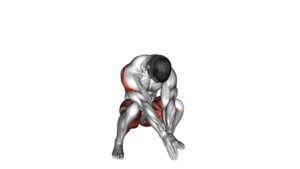Supine Spinal Twist Yoga Pose – Video Exercise Guide & Tips

Get ready to twist and stretch with the supine spinal twist yoga pose.
Watch This Exercise Video
In this video exercise guide, you'll discover the benefits of this pose, learn how to prepare for it, and receive step-by-step instructions to perfect your form.
Avoid common mistakes and explore modifications to make the pose work for you.
Plus, we'll share tips for deepening your practice.
Let's jump in and unlock the power of the supine spinal twist!
Key Takeaways
- Supine Spinal Twist improves flexibility.
- Supine Spinal Twist relieves lower back pain.
- Supine Spinal Twist increases range of motion.
- Supine Spinal Twist helps release tension in the lower back.
Benefits of Supine Spinal Twist
Experience the numerous benefits of practicing the Supine Spinal Twist yoga pose. This pose is highly effective in improving flexibility and relieving lower back pain. By gently twisting your spine while lying on your back, you can stretch and lengthen the muscles along your spine, increasing your range of motion. This can be especially beneficial for those who spend long hours sitting or have a sedentary lifestyle.
The Supine Spinal Twist also helps relieve tension in the lower back. As you twist, you're able to release tightness and stiffness in the muscles of the lower back, providing much-needed relief. This can be particularly helpful for individuals who experience chronic lower back pain or discomfort.
In addition to its physical benefits, the Supine Spinal Twist also has mental and emotional benefits. The twisting motion stimulates the digestive system, promoting healthy digestion and detoxification. It also helps calm the mind and reduce stress, making it a great pose to practice before bed or during times of high stress.
To prepare for the Supine Spinal Twist, find a comfortable space on your mat and lie on your back. Keep your legs extended and your arms relaxed by your sides. Take a moment to connect with your breath and center yourself before moving into the pose.
Preparing for the Pose
Before you begin the Supine Spinal Twist yoga pose, it's important to focus on proper alignment. Pay attention to the position of your hips, shoulders, and spine to ensure that you're maintaining the correct form.
Alignment Tips for Beginners
Get into proper alignment for the Supine Spinal Twist yoga pose by following these beginner-friendly tips.
As a beginner, it's important to make modifications to the pose to find balance and avoid strain. Start by lying on your back with your knees bent and feet flat on the floor. Keep your arms relaxed by your sides.
As you exhale, gently drop both knees to one side, allowing your hips to twist. You can place a bolster or folded blanket under your knees for support. Keep your shoulders grounded as you turn your head in the opposite direction of your knees.
Remember to listen to your body and only go as far as feels comfortable. With practice, you'll gradually be able to deepen the twist and improve your alignment.
Benefits of Proper Preparation
To maximize the benefits of the Supine Spinal Twist yoga pose, it's essential to properly prepare your body for the pose by following these alignment tips for beginners. Preparing properly and warming up your body before attempting the pose can help prevent injury and enhance your overall experience.
Here are some key benefits of proper preparation:
- Reduced risk of injury: Engaging in warm-up exercises helps to loosen up your muscles, ligaments, and joints, reducing the risk of strains or pulls during the pose.
- Increased flexibility: Warming up allows your body to gradually increase its range of motion, making it easier to achieve and hold the Supine Spinal Twist pose.
- Improved circulation: Preparing your body through warm-up exercises helps to increase blood flow and oxygen delivery to the muscles, enhancing their performance during the pose.
- Enhanced focus and concentration: Proper preparation helps to calm the mind and bring awareness to your body, allowing you to fully engage in the pose and experience its benefits.
Step-by-Step Guide to Supine Spinal Twist
Lie down on your back and bend your knees in the supine spinal twist yoga pose. This pose is a great way to stretch and release tension in your lower back, hips, and spine. Before attempting the supine spinal twist, it's recommended to perform some preparatory stretches to warm up your body and increase flexibility. These stretches can include gentle twists, seated forward folds, and hip-opening exercises.
To begin the supine spinal twist, start by lying on your back with your legs extended. Bend your knees and bring them towards your chest. Inhale deeply, and as you exhale, drop both knees towards your right side. Keep your shoulders grounded on the mat and try to keep your knees stacked on top of each other. You can use your left hand to gently guide your knees closer to the ground. Stay in this position for a few breaths, feeling the stretch in your lower back and hips.
To transition into the next section about common mistakes to avoid, remember to keep your spine long and avoid any strain or discomfort. It's important to listen to your body and only go as far as feels comfortable for you. Pushing yourself too hard in this pose can lead to injury.
Now, let's explore some common mistakes to avoid in the supine spinal twist.
Common Mistakes to Avoid
When practicing the supine spinal twist yoga pose, it's important to pay attention to proper alignment techniques. Avoid excessive twisting, as this can strain the spine and lead to injury.
Remember to take deep breaths throughout the pose, allowing your body to relax and deepen the stretch.
Proper Alignment Techniques
Ensure correct alignment in the Supine Spinal Twist yoga pose by keeping your knees stacked and shoulders grounded. Proper alignment techniques are crucial to avoid strain and injury. Here are some modification options to help you maintain the correct alignment:
- Keep your knees stacked: Aligning your knees vertically helps to prevent any strain on the hips or lower back. If you find it challenging to keep your knees stacked, you can use a yoga block or blanket for support.
- Ground your shoulders: Ensure that both of your shoulders stay firmly planted on the ground throughout the pose. This helps to maintain stability and prevents any unnecessary tension in the upper body.
Avoiding Excessive Twisting
To prevent strain and injury, it's important to be mindful of excessive twisting in the Supine Spinal Twist yoga pose.
While it's a great pose for stretching the spine and releasing tension, it's crucial to avoid going too deep into the twist. Excessive twisting can put unnecessary strain on the spine, neck, and shoulders.
To avoid this, it's recommended to warm up the body with gentle stretches before attempting the pose. Additionally, incorporating exercises to strengthen the core can help provide stability and support during the twist.
Importance of Deep Breaths
Take deep breaths to enhance the benefits of the Supine Spinal Twist yoga pose and avoid common mistakes. Deep breathing is a crucial aspect of practicing yoga as it helps to deepen the stretch, release tension, and promote relaxation.
Here are some important breathing techniques and relaxation techniques to keep in mind while performing the Supine Spinal Twist:
- Focus on your breath: Pay attention to your breath as you move into the pose. Inhale deeply through your nose, filling your lungs with air, and exhale slowly through your mouth, releasing any tension or tightness in your body.
- Lengthen your breath: Try to lengthen your inhales and exhales, taking slow and controlled breaths. This will help to calm your mind and bring a sense of tranquility.
Modifications and Variations
Explore different ways to modify and vary the Supine Spinal Twist yoga pose for a more personalized and dynamic practice. Modifications can be made to accommodate different body types, flexibility levels, or to address specific concerns or limitations.
One modification is to use a prop like a bolster or blanket under the knees to provide support and reduce strain on the lower back. This can be especially helpful for beginners or those with tight hips or lower back issues.
Another modification is to bend the bottom knee and place the foot on the ground for added stability. This can be beneficial for individuals who struggle to maintain balance in the traditional pose.
For those looking for advanced variations, one option is to extend the top arm overhead, reaching towards the opposite side of the body. This intensifies the stretch in the shoulders and upper back, while also engaging the core muscles.
Another advanced variation is to add a bind by wrapping the top arm around the back and reaching for the opposite thigh. This deepens the twist and challenges the flexibility of the shoulders and spine.
Remember to listen to your body and only attempt advanced variations if you feel comfortable and confident in your practice. Modifying and varying the Supine Spinal Twist allows you to tailor the pose to your needs, ensuring a safe and effective yoga practice.
Tips for Deepening Your Practice
As you deepen your practice of the Supine Spinal Twist yoga pose, you can further enhance its benefits and explore new levels of flexibility and strength. Here are some tips to help you deepen your practice and find balance:
- Focus on your breath: As you move into the pose, pay attention to your breath. Take slow, deep breaths to help you relax and release tension. Inhale deeply as you lengthen your spine, and exhale as you twist deeper into the pose.
- Use props: If you find it challenging to keep your knees stacked or to reach your opposite hand to the floor, you can use props to support your body. Place a bolster or folded blanket under your knees for support, or use a block to bring the floor closer to your hand.
- Explore variations: Once you feel comfortable in the basic Supine Spinal Twist pose, you can start to explore variations to deepen the stretch. You can try extending your top leg straight out in front of you or bending your bottom knee and placing your foot on the ground for a deeper twist.
- Listen to your body: Remember to always listen to your body and respect its limits. If you feel any pain or discomfort, ease out of the pose or modify it to suit your needs. It's important to find a balance between challenging yourself and practicing with mindfulness and care.
Frequently Asked Questions
Is the Supine Spinal Twist Pose Safe for Individuals With Lower Back Pain?
If you have lower back pain, you may be wondering if the supine spinal twist pose is safe for you. While this pose can provide benefits such as improving spinal mobility and relieving tension, it may not be suitable for everyone.
It's always a good idea to talk to a healthcare professional or a qualified yoga instructor who can recommend alternative poses or modifications that will be safer for your specific condition.
How Long Should One Hold the Supine Spinal Twist Pose?
To determine how long to hold the supine spinal twist pose, consider the benefits it offers. This pose helps to release tension in your lower back and increase spinal mobility. Holding it for at least 30 seconds allows your muscles to relax and stretch properly.
However, if you're a beginner, start with shorter holds and gradually increase the time as you become more comfortable. Listen to your body and find a duration that feels right for you.
Can Supine Spinal Twist Pose Help With Digestion?
Supine spinal twist pose, a yoga for digestion, offers several benefits.
By gently twisting your spine, it stimulates the digestive organs, promoting better digestion.
This pose can also relieve bloating and gas, aiding in overall digestion.
Additionally, it helps to release tension in the back and hips, improving flexibility.
Regular practice of supine spinal twist pose can contribute to a healthier digestive system and increased comfort after meals.
Are There Any Contraindications or Precautions to Be Aware of Before Practicing Supine Spinal Twist?
Before practicing supine spinal twist, it's important to be aware of any contraindications or precautions. Understanding these will help ensure a safe practice.
Some contraindications may include recent abdominal surgery, herniated discs, or spinal injuries.
Precautions include moving slowly and mindfully, listening to your body, and modifying the pose as needed.
Consulting with a healthcare professional or experienced yoga teacher can provide further guidance specific to your individual needs.
Can Supine Spinal Twist Pose Help Alleviate Stress and Anxiety?
Supine spinal twist pose can indeed help alleviate stress and anxiety. By gently twisting your spine while lying on your back, this pose helps release tension and relax your body and mind.
The benefits of supine spinal twist include improved digestion, increased spinal flexibility, and relief from lower back pain. There are different variations of this pose, such as using props or modifying the intensity.
Take a moment to explore this pose and experience its calming effects.
Conclusion
In conclusion, the supine spinal twist is a beneficial yoga pose that can help improve flexibility, relieve tension in the back, and promote relaxation.
By following the step-by-step guide and avoiding common mistakes, you can safely and effectively practice this pose.
Remember to listen to your body and make modifications or variations as needed.
With regular practice and proper technique, you can deepen your supine spinal twist and enhance your yoga practice.

Author
Years ago, the spark of my life’s passion ignited in my mind the moment I stepped into the local gym for the first time. The inaugural bead of perspiration, the initial endeavor, the very first surge of endorphins, and a sense of pride that washed over me post-workout marked the beginning of my deep-seated interest in strength sports, fitness, and sports nutrition. This very curiosity blossomed rapidly into a profound fascination, propelling me to earn a Master’s degree in Physical Education from the Academy of Physical Education in Krakow, followed by a Sports Manager diploma from the Jagiellonian University. My journey of growth led me to gain more specialized qualifications, such as being a certified personal trainer with a focus on sports dietetics, a lifeguard, and an instructor for wellness and corrective gymnastics. Theoretical knowledge paired seamlessly with practical experience, reinforcing my belief that the transformation of individuals under my guidance was also a reflection of my personal growth. This belief holds true even today. Each day, I strive to push the boundaries and explore new realms. These realms gently elevate me to greater heights. The unique combination of passion for my field and the continuous quest for growth fuels my drive to break new ground.







